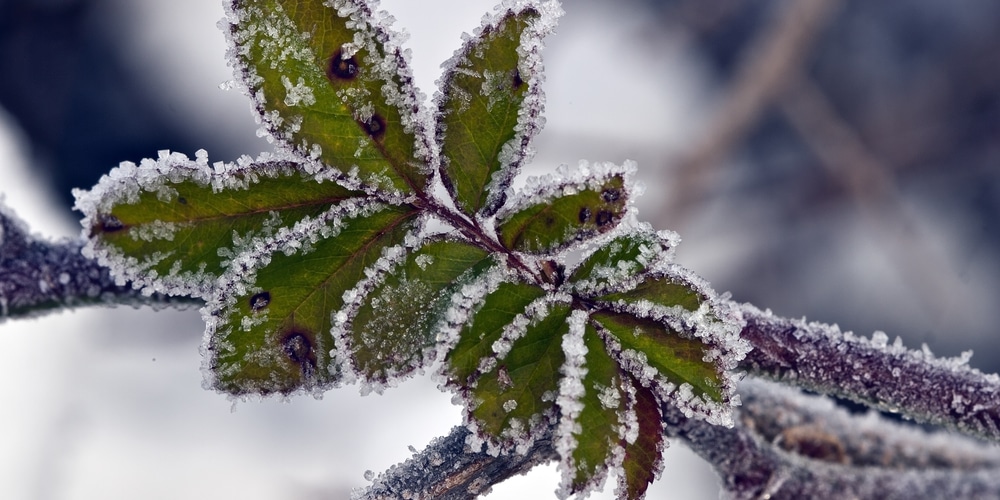For most people, the chilly weather means taking on other activities like snowboarding, ice skating, and hot chocolate by the fireplace. But if you’re a gardener, you know that these chilly months also bring a whole new set of challenges – like how to keep your plants alive.
While frost can damage and even kill many types of plants, there are some – like blueberries – that are more tolerant.
But even blueberry plants have their limits. So, how much frost can they tolerate, and how can you help them survive?
Blueberry Plants and Frost
Frost occurs when the air temperature drops below freezing (32 degrees Fahrenheit), and it can cause damage to plants in a number of ways. The most common type of damage is called “desiccation,” which occurs when the water inside the plant cells freezes.
This can cause the cell walls to rupture, leading to wilting and eventually death. Frost can also cause damage by creating ice crystals that puncture plant cells or by drying out the plant tissues.
While most plants are damaged by even a light frost, blueberries are more tolerant. This is because they have a natural antifreeze called “dormancy.” Dormancy is a state of reduced activity that helps plants to survive cold weather.
When the temperature drops, blueberry plants will go into dormancy, and their metabolism will slow down. This helps to protect them from the damaging effects of frost.
However, even blueberry plants have their limits. They can only tolerate so much cold before they are damaged. The amount of frost that a plant can tolerate depends on the type of plant, the stage of growth, and the air temperature.
For example, young plants and flowers are usually more sensitive to frost than mature plants. And while blueberries can tolerate some cold, they are not designed to withstand prolonged freezing temperatures.
Your blueberry plants won’t experience any damage from a light frost (32 degrees Fahrenheit), but they may be damaged by a hard frost (28 degrees Fahrenheit). You’ll need to take some steps to protect your plants for temperatures lower than this.
How to Help Your Blueberries Survive Frost
While blueberry plants are more tolerant of frost than most other plants, there are still some things you can do to help them survive the cold weather.
Here are a few tips:
Cover Your Blueberry Plants
Winter can be tough on blueberry plants. The cold weather can damage the delicate flowers, causing them to drop off before they have a chance to set fruit. Frost can also damage the young berries, making them smaller and less flavorful.
While they’re hardy and can tolerate some cold, they’re not designed to withstand prolonged freezing temperatures. If the temperature is forecast to drop below 28 degrees Fahrenheit, you’ll need to take some steps to protect your plants.
One way to protect them from frost is to cover the plants with a sheet or tarp. Covering plants has been shown to increase the temperature around the plants by a few degrees, which can make a big difference.
Just be sure to remove the cover during the day so that the plants can get some sunlight.
For blueberries, this should be done once the temperature has dipped below 20 degrees Fahrenheit and is forecast to stay there for more than four hours. Although some damage will be done to the plants if the temperature goes down to 28, some plants may survive.
Blankets, burlap, propylene, or other materials can be used to protect blueberry plants from frost. This is to prevent heat loss protecting the plants from the cold.
Water Your Plants Before a Frost
Another way to protect your plants from frost is to water them before the temperature drops. When the ground is wet, it will help to insulate the roots of the plants and keep them warm. This can make a big difference in whether or not your plants survive a cold snap.
Just be sure not to water too close to the time of the frost. If the ground is still frozen, the water will just sit on top and won’t do much to help the plants.
You should also avoid watering during the day when the sun is out. The water will evaporate quickly, leaving the plants vulnerable to the cold.
Move Your Plants Indoors
If you’re really worried about your plants surviving a cold snap, you can always move them indoors. This is usually only necessary for very delicate plants, such as those that are just starting to grow.
If you do decide to move your plants indoors, be sure to put them in a spot where they will get plenty of sunlight. They will also need to be watered more frequently, as the indoor air is much drier than the outdoor air.
How to Properly Cover Your Blueberry Plant
Among all the tips to help your blueberry plant survive frost, covering it is the most effective way to prevent damage from cold weather.
When done properly, covering your blueberry plant can raise the temperature around the plant by as much as 15 degrees Fahrenheit.
There are two main ways to cover a blueberry plant: using a tarp or fabric or building a makeshift wooden frame around the plant.
If you live in an area with very little snowfall, then covering your blueberry plant with a tarp or fabric will be sufficient. However, if you live in an area with heavy snowfall, you’ll need to build a frame around the plant to keep the weight of the snow from crushing the plant.
In either case, it’s important to make sure that the cover is securely fastened so that it doesn’t blow away in the wind. You should also remove the cover when the temperature starts to warm up so that your plant doesn’t overheat.
Can blueberry plants survive frost: Conclusion
With a little preparation, you can help your blueberry plant survive even the harshest winters. Just be sure to take the necessary steps to protect them from the cold.
Related Article: How Big Do Blueberry Bushes Get?

